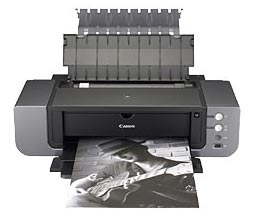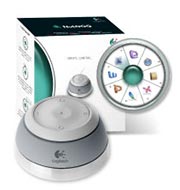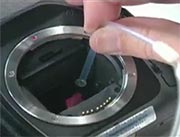If you are one of the digital photographers who feel that every shot should be perfect just the way it exits the camera, put down the keyboard and step away from the computer. There's nothing to see here, go back to your homes.
But if you are a realist, you know that the shutter click was the beginning of a larger process, often involving major technologies, creative video-game-like image manipulations and Photoshop.
As image-conscious enthusiasts and professionals, the tools you use can make or break your day. This year's PMA revealed and premiered several new tools that will make your day. And mine.
huey

 From PANTONE/gretagmacbeth, the huey Monitor Color Corrector is possibly the most pleasant tweak you can make to your computer screen.
From PANTONE/gretagmacbeth, the huey Monitor Color Corrector is possibly the most pleasant tweak you can make to your computer screen.
The hardware is a slim suction probe that is used to evaluate your monitor, then sits in a stand, continuously monitoring the light in your edit space, adjusting the display every ten seconds. As room light changes, so does your monitor. It's subtle, but effective.
Powering the probe is a graphic program that quickly feeds the patterns of color and tonality to the probe so the sensors can read the phosphors or LCD colors and make sense of them. In all, 26 tests are made in about two minutes. (Hue -y, get it?)
Just so the probe can do its best, the $79 package (street price) includes two Klear Screen travel singles--disposable wet screen wipes.
It weighs nothing, travels well and even includes a little USB extension cord.
 Big Print
Big Print
Canon introduced the iPF 5000--a printer using Lucia pigment inks (think long print life) and large size--17-inches wide by however long you wish (think roll feed).
Sporting a new brand name, the imagePrograf iPF 5000 is the first of at least three. Next models will be 24 inches and 44 inches wide by however long your roll is.
Wilhelm Research pegs the images at 100+ years for color and much longer for B&W.
Pigment inks are not only long-life, they tend to work with a greater range of papers, making this a significant printer for professionals and advanced enthusiasts. It uses a new dual-head design with --get this-- 30,720 nozzels with 2,560 per color. And with twelve colors, it tips the scales as the ink-count leader until the Zorgop 24-ink BZ 2400 appears later this century.
Ink colors include magenta, photo magenta, cyan, photo cyan, yellow, regular black, matte black, red, blue, green, gray and photo gray.
How much? Two grand. When? April.
 Pretty Big Print
Pretty Big Print
Canon also introduced the Pixma Pro9500, also a pigment ink printer 13 inches wide with 10 inks.
Fine art print longevity meets the 13 x 19-inch Super Tabloid size page.
This one comes into your life for a mere $n/a. Delivery in mid-n/a. Hey, where did the info go? Canon's not saying. Yet.
Control Freq
 Logitech has a knob up its sleeve. Looking nothing like an elbow, the NuLOOQ navigation system starts with a three dimensional control accessory designed to work in conjunction with mouse and keyboard. Wouldn't you know it, Logitech sells those, too.
Logitech has a knob up its sleeve. Looking nothing like an elbow, the NuLOOQ navigation system starts with a three dimensional control accessory designed to work in conjunction with mouse and keyboard. Wouldn't you know it, Logitech sells those, too.
The NuLOOQ is a 2.2-inch wide USB-powered weighty cylinder that brings intuitive three dimensional control to the entire suite of programs in the Adobe CS2 suite. More software titles are in the works.
Your fingers grab the rubbery gray "navring" and push in any direction, twist left and right causing the image on screen to zoom and slide to where you want it. It almost takes longer to describe it than to get used to the idea. Atop the NuLOOQ are five triggerpoints for easy custom or program-specific functions.
The software suite is extensive and very clever. By combining mouse clicks and NuLOOQ moves, the image on screen is tremendously easier to manipulate and encounter. Visit their web site for more details and try the software on your computer for a month.
Question number one: Answer: $150 or less. Worth it? Oh, yes.
Designed to Suck
 Get the @D#U$S%T&!! off my sensor. Okay, the best solution to date involved various wipers and fluids. Enter a new idea: Nothing. Rather the near absence of something. A vacuum cleaner half the diameter of a pencil. The vacuum solution from Green Clean USA.
Get the @D#U$S%T&!! off my sensor. Okay, the best solution to date involved various wipers and fluids. Enter a new idea: Nothing. Rather the near absence of something. A vacuum cleaner half the diameter of a pencil. The vacuum solution from Green Clean USA.
It takes a number of elements to create an effective vacuum cleaner for something as delicate and critical as an image sensor chip, first among them an effective source of vacuum.
So an engineer-inventor in Salzburg, Austria, Anneliese Lettner, came up with the idea of a venturi vacuum cleaner for small delicate instruments. Pressurized gas creates a vacuum if you use it to pull in a side stream of air, so this vac is powered by a can of environmentally friendly propellant. A pro model and travel model are available.
Touching a sensor with anything that engenders static is a no-no, so she added a tip made of a special surgical plastic. Tip shape is a miniature trumpet flare. Put them all together and you've got your dust sucked while your static ions haven't been shoved around.
Polishing off the green cleaning cycle is an advanced swab wiper system. Combined, you're covered. Or perhaps uncovered, dust-wise.
Under $75 for the pro kit with vac, propellent, special tubes, cloth and swabs.
Other Stuff
Sure, there were other gizmos and accessories, cameras and lenses, bags and baggage, but this year seemed more evolutionary in those departments than revolutionary.
I commend your attention to these sites for more detailed coverage:
Imaging Resource (dot com)
DP Review
-iNova
Get the eBooks. Versions are now shipping for the D70, EOS 300D, EOS 350D, EOS 20D and earlier Coolpix and Sony Advanced Cyber-shot cameras. We have a secure order page that will allow previous eBook owners to upgrade for low cost, too. Or you can call direct and order from the publisher by phone or FAX.
 Or At Least, Refresh Your Editing
Or At Least, Refresh Your Editing
 From PANTONE/gretagmacbeth, the
From PANTONE/gretagmacbeth, the  Big Print
Big Print Pretty Big Print
Pretty Big Print Logitech has a knob up its sleeve. Looking nothing like an elbow, the
Logitech has a knob up its sleeve. Looking nothing like an elbow, the  Get the @D#U$S%T&!! off my sensor. Okay, the best solution to date involved various wipers and fluids. Enter a new idea: Nothing. Rather the near absence of something. A vacuum cleaner half the diameter of a pencil. The vacuum solution from
Get the @D#U$S%T&!! off my sensor. Okay, the best solution to date involved various wipers and fluids. Enter a new idea: Nothing. Rather the near absence of something. A vacuum cleaner half the diameter of a pencil. The vacuum solution from